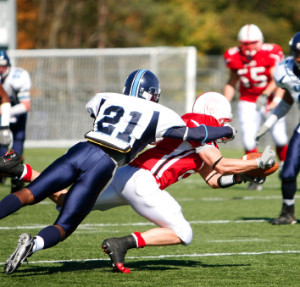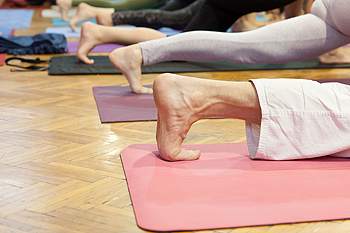Middlefield (860) 349-8500
Wallingford (203) 294-4977
Middlefield (860) 349-8500
Wallingford (203) 294-4977
 The tarsal tunnel is a narrow tunnel in the ankle, next to the ankle bone, that serves as a pathway for nerves, veins, arteries and tendons. Tarsal tunnel syndrome occurs when the tibial nerve in this tunnel gets squeezed or pressed. Common causes of tarsal tunnel syndrome include osteoarthritis, rheumatoid arthritis, diabetes, overpronation (rolling) of the foot, or a cyst or ganglion that can form near the tunnel. Symptoms of tarsal tunnel syndrome include a burning pain that radiates to the arch of the foot, numbness in the sole of the foot and worsening of symptoms after running or standing for a long time. If you believe that you might be suffering from tarsal tunnel syndrome, it is important to visit a podiatrist for a proper diagnosis and treatment. Treatment options that may be considered include cold therapy, medication, injections, specific exercises, corticosteroid injections or surgery.
The tarsal tunnel is a narrow tunnel in the ankle, next to the ankle bone, that serves as a pathway for nerves, veins, arteries and tendons. Tarsal tunnel syndrome occurs when the tibial nerve in this tunnel gets squeezed or pressed. Common causes of tarsal tunnel syndrome include osteoarthritis, rheumatoid arthritis, diabetes, overpronation (rolling) of the foot, or a cyst or ganglion that can form near the tunnel. Symptoms of tarsal tunnel syndrome include a burning pain that radiates to the arch of the foot, numbness in the sole of the foot and worsening of symptoms after running or standing for a long time. If you believe that you might be suffering from tarsal tunnel syndrome, it is important to visit a podiatrist for a proper diagnosis and treatment. Treatment options that may be considered include cold therapy, medication, injections, specific exercises, corticosteroid injections or surgery.
Tarsal tunnel syndrome can be very uncomfortable to live with. If you are experiencing tarsal tunnel syndrome, contact Dr. Gordon Fosdick of Affiliated Foot Care Center. Our doctor can provide the care you need to keep you pain-free and on your feet.
Tarsal Tunnel Syndrome
Tarsal tunnel syndrome, which can also be called tibial nerve dysfunction, is an uncommon condition of misfiring peripheral nerves in the foot. The tibial nerve is the peripheral nerve in the leg responsible for sensation and movement of the foot and calf muscles. In tarsal tunnel syndrome, the tibial nerve is damaged, causing problems with movement and feeling in the foot of the affected leg.
Common Cause of Tarsal Tunnel Syndrome
The Effects of Tarsal Tunnel Syndrome
A physical exam of the leg can help identify the presence of tarsal tunnel syndrome. Medical tests, such as a nerve biopsy, are also used to diagnose the condition. Patients may receive physical therapy and prescriptive medication. In extreme cases, some may require surgery.
If you have any questions please feel free to contact our offices located in Middlefield and Wallingford, CT . We offer the newest diagnostic and treatment technologies for all your foot and ankle needs.
 The five metatarsal bones, plus the tendons and ligaments that create the arch at the top of the foot and connect the midfoot to the forefoot, are known as the Lisfranc joint complex. These ligaments and tendons can be sprained, or the metatarsal bones can be fractured, resulting in what is known as a “Lisfranc Injury.” Because the Lisfranc joint transfers force through the toes and allows pushing off, most injuries to this area involve upward, downward, or twisting forces to the foot. Lisfranc injuries are common in sports like football, when the foot is stepped on, twisted while pointing, or stepped on while facing down. Most Lisfranc injuries require 6 weeks of avoiding weight-bearing activities, followed by rehab. Surgery may be necessary as well. If you believe that you have suffered a Lisfranc injury, it is important to consult with a podiatrist as soon as possible. This will allow for proper diagnosis and treatment.
The five metatarsal bones, plus the tendons and ligaments that create the arch at the top of the foot and connect the midfoot to the forefoot, are known as the Lisfranc joint complex. These ligaments and tendons can be sprained, or the metatarsal bones can be fractured, resulting in what is known as a “Lisfranc Injury.” Because the Lisfranc joint transfers force through the toes and allows pushing off, most injuries to this area involve upward, downward, or twisting forces to the foot. Lisfranc injuries are common in sports like football, when the foot is stepped on, twisted while pointing, or stepped on while facing down. Most Lisfranc injuries require 6 weeks of avoiding weight-bearing activities, followed by rehab. Surgery may be necessary as well. If you believe that you have suffered a Lisfranc injury, it is important to consult with a podiatrist as soon as possible. This will allow for proper diagnosis and treatment.
Sports related foot and ankle injuries require proper treatment before players can go back to their regular routines. For more information, contact Dr. Gordon Fosdick of Affiliated Foot Care Center. Our doctor can provide the care you need to keep you pain-free and on your feet.
Sports Related Foot and Ankle Injuries
Foot and ankle injuries are a common occurrence when it comes to athletes of any sport. While many athletes dismiss the initial aches and pains, the truth is that ignoring potential foot and ankle injuries can lead to serious problems. As athletes continue to place pressure and strain the area further, a mild injury can turn into something as serious as a rupture and may lead to a permanent disability. There are many factors that contribute to sports related foot and ankle injuries, which include failure to warm up properly, not providing support or wearing bad footwear. Common injuries and conditions athletes face, including:
Sports related injuries are commonly treated using the RICE method. This includes rest, applying ice to the injured area, compression and elevating the ankle. More serious sprains and injuries may require surgery, which could include arthroscopic and reconstructive surgery. Rehabilitation and therapy may also be required in order to get any recovering athlete to become fully functional again. Any unusual aches and pains an athlete sustains must be evaluated by a licensed, reputable medical professional.
If you have any questions please feel free to contact our offices located in Middlefield and Wallingford, CT . We offer the newest diagnostic and treatment technologies for all your foot and ankle needs.
 There are many people worldwide who suffer from general foot pain. This may be partially or fully alleviated when frequent foot stretches are performed. A common and painful foot condition known as plantar fasciitis typically targets the heel and arch area. It may be beneficial to roll the bottom of the foot on a tennis ball, as this can help to stretch the plantar fascia. Swelling and redness are often symptoms that accompany a bunion, and it may feel better to stretch the toes. People who have jobs that require standing for the majority of the day and experience sore feet may benefit from elevating the feet as often as possible, in addition to massaging areas of the foot that are painful. If you would like more information about the benefits of stretching the feet, please consult with a podiatrist
There are many people worldwide who suffer from general foot pain. This may be partially or fully alleviated when frequent foot stretches are performed. A common and painful foot condition known as plantar fasciitis typically targets the heel and arch area. It may be beneficial to roll the bottom of the foot on a tennis ball, as this can help to stretch the plantar fascia. Swelling and redness are often symptoms that accompany a bunion, and it may feel better to stretch the toes. People who have jobs that require standing for the majority of the day and experience sore feet may benefit from elevating the feet as often as possible, in addition to massaging areas of the foot that are painful. If you would like more information about the benefits of stretching the feet, please consult with a podiatrist
Stretching the feet is a great way to prevent injuries. If you have any concerns with your feet consult with Dr. Gordon Fosdick from Affiliated Foot Care Center. Our doctor will assess your condition and provide you with quality foot and ankle treatment.
Stretching the Feet
Being the backbone of the body, the feet carry your entire weight and can easily become overexerted, causing cramps and pain. As with any body part, stretching your feet can serve many benefits. From increasing flexibility to even providing some pain relief, be sure to give your feet a stretch from time to time. This is especially important for athletes or anyone performing aerobic exercises, but anyone experiencing foot pain or is on their feet constantly should also engage in this practice.
Great ways to stretch your feet:
Individuals who tend to their feet by regular stretching every day should be able to minimize foot pain and prevent new problems from arising.
If you have any questions, please feel free to contact our offices located in Middlefield and Wallingford, CT . We offer the newest diagnostic and treatment technologies for all your foot care needs.
 Fungal nail infections are a common problem that can last for long periods of time and may recur in some individuals. Carefully following the care instructions given to you by your doctor is one of the most important steps to curing this condition. In addition to treatment provided by your doctor, you can also take certain measures at home to help your feet. Wash your feet often and always dry them thoroughly. Keep your nails clean, dry, and neatly trimmed. Since fungi thrive in warm, moist environments, it is important to change out your socks and shoes frequently, especially if you sweat a lot. Avoid walking barefoot in public places, and don’t share personal items, such as towels or nail clippers, to avoid spreading the fungus. For more information about toenail fungus treatment and prevention strategies, consult with a podiatrist.
Fungal nail infections are a common problem that can last for long periods of time and may recur in some individuals. Carefully following the care instructions given to you by your doctor is one of the most important steps to curing this condition. In addition to treatment provided by your doctor, you can also take certain measures at home to help your feet. Wash your feet often and always dry them thoroughly. Keep your nails clean, dry, and neatly trimmed. Since fungi thrive in warm, moist environments, it is important to change out your socks and shoes frequently, especially if you sweat a lot. Avoid walking barefoot in public places, and don’t share personal items, such as towels or nail clippers, to avoid spreading the fungus. For more information about toenail fungus treatment and prevention strategies, consult with a podiatrist.
If left untreated, toenail fungus may spread to other toenails, skin, or even fingernails. If you suspect you have toenail fungus it is important to seek treatment right away. For more information about treatment, contact Dr. Gordon Fosdick of Affiliated Foot Care Center. Our doctor can provide the care you need to keep you pain-free and on your feet.
Symptoms
Treatment
If self-care strategies and over-the-counter medications does not help your fungus, your podiatrist may give you a prescription drug instead. Even if you find relief from your toenail fungus symptoms, you may experience a repeat infection in the future.
Prevention
In order to prevent getting toenail fungus in the future, you should always make sure to wash your feet with soap and water. After washing, it is important to dry your feet thoroughly especially in between the toes. When trimming your toenails, be sure to trim straight across instead of in a rounded shape. It is crucial not to cover up discolored nails with nail polish because that will prevent your nail from being able to “breathe”.
In some cases, surgical procedure may be needed to remove the toenail fungus. Consult with your podiatrist about the best treatment options for your case of toenail fungus.
If you have any questions, please feel free to contact our offices located in Middlefield and Wallingford, CT . We offer the newest diagnostic and treatment technologies for all your foot care needs.